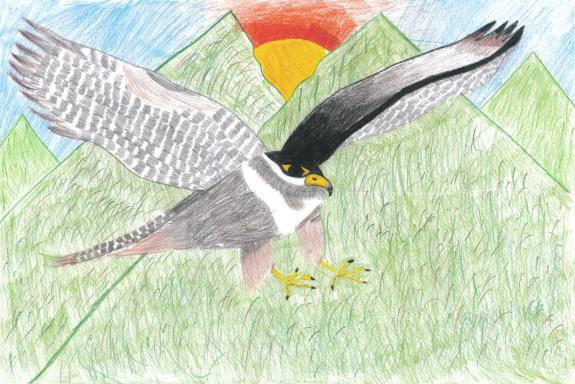Anna Ursin, Reverand Brown School
Sussex County
 Second Place, Sussex County, Peregrine Falcon (c) Anna Ursin
Second Place, Sussex County, Peregrine Falcon (c) Anna Ursin
The Peregrine Falcon
Oh no! Do you see how those humans are destroying my habitat? All seven of my brittle eggs are in my nest right near those three, careless humans! If that boy jerks his foot, my nest is gone, along with my eggs. Do people not have enough space of their own? Why do they have to invade mine? I am Peppy, the Peregrine Falcon. I am a protected, endangered species that is very interesting for many reasons, needs your help so I do not become extinct in the future, and can be helped in many great ways.
Peregrine falcons are super cool birds! They have pointy wings and long tails. Adults have grayish-bluish bodies and have white feathers around their heads, while juniors have vertical streaks on their bellies and breasts, dark heads and white around their eyes. Peregrines eat bats, rodents, small birds, and large insects. The prey of this bird has a 60 percent chance of escaping the swooping individual that is trying to eat it. They nest incliffs, tundra, deserts, tropics, islands, forests, wetlands, mountains, and savannas. Peregrine falcons are very unique birds.
Peregrine falcons, sadly enough, are endangered for many reasons. These special birds like to nest near water, but people like to build giant cities near water. When the habitats of birds get invaded, the birds are forced to leave their eggs behind, because there is no way that they can take the eggs with them. A few years ago, people were putting a strong chemical called DDT out in their yards. DDT makes eggshells brittle and weak, so the chicks will often be born too early and they will die. If peregrine falcons die, then the food chain will totally get mixed up. These birds might become extinct later in time!
Even though peregrine falcons are protected, they are still endangered and need help. One way to help is by simply not putting out DDT and set up bird traps. Luckily, DDT is ilow illegal. Another is to donate money to trustworthy funds that help falcons live ina safe clean environment where they have access to clean water and an assortment of food. The last cool way to help save peregrines is to not invade their habitat. People can share space with peregrine falcons for sure, but it is just plain wrong to totally invade a spot that they were in first. If you decide to share space will a family of peregrines, do not harm their eggs, touch them unnecessarily, or hurt them in any way. Peregrines have had a rough past, but with help from humans, they could have an excellent future!
Wow! That was a close one! Luckily, those humans left my nest alone. Good thing they did not touch my eggs. They are pretty fragile. Now that you have learned more about my species, don't you think we are interesting? Doesn't our interestingness make you want to help us? As you can see, you don't need to do much to lend my species a hand, just do not be careless and spread awareness. Well, I have to go catch my dinner. Oooh! Do you see that tasty rat scurrying on the cliff? Rats are my favorite thing to eat! Gotta fly! Bye!
Written by: Anna Ursin
Reverend Brown School, Sparta, NJ
Teacher: Miss Racioppi




